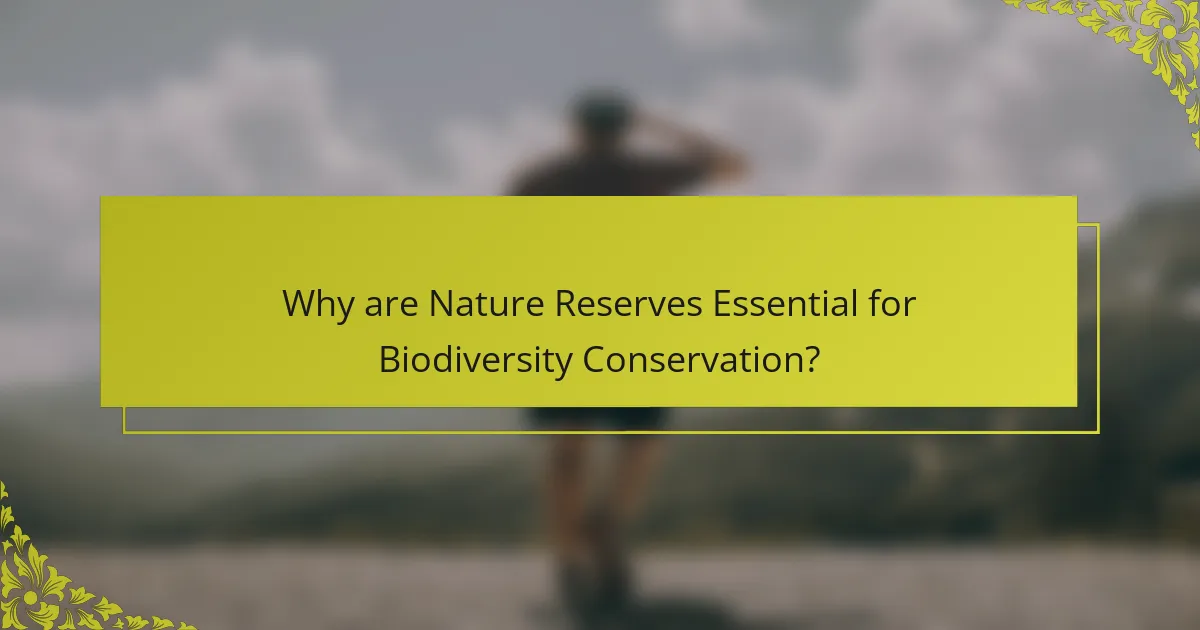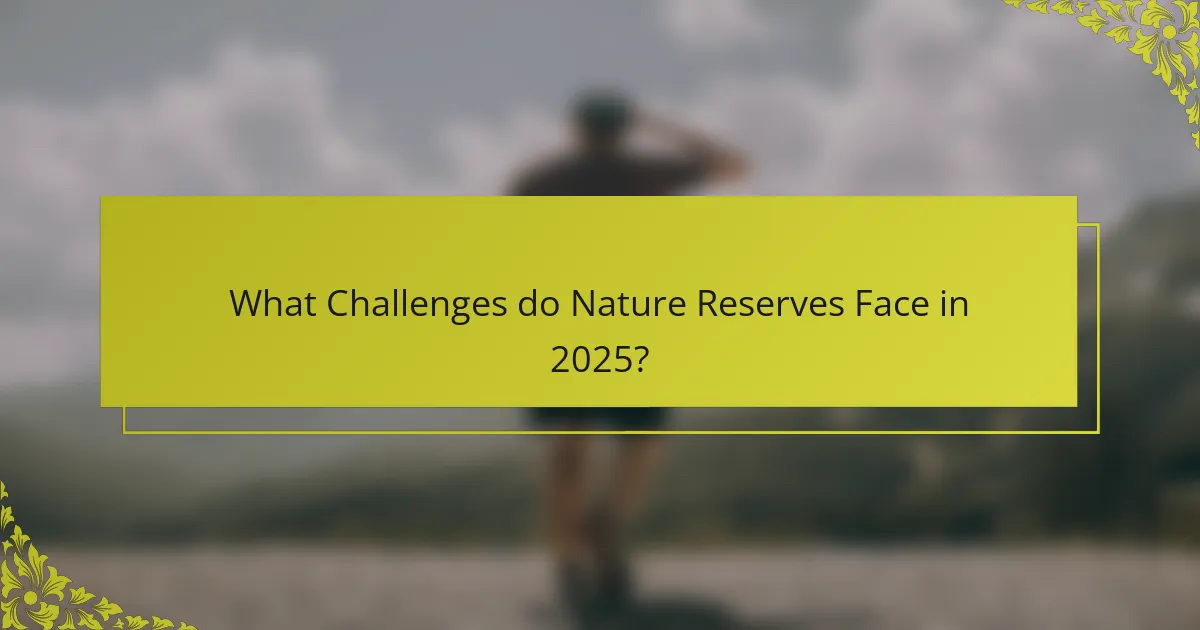Nature reserves play a crucial role in protecting biodiversity and ecosystems from human activities. This article explores their importance for wildlife conservation, highlights key conservation efforts, and outlines essential visitor guidelines to ensure sustainable enjoyment of these natural sanctuaries. Understanding these aspects is vital for fostering a culture of stewardship and addressing current challenges faced by nature reserves.

Why are Nature Reserves Essential for Biodiversity Conservation?
Nature reserves are essential for biodiversity conservation as they protect ecosystems and species from human activities. These areas serve as sanctuaries for wildlife, preserving genetic diversity and promoting ecological balance. Nature reserves also provide critical habitats for endangered species, contributing to their recovery. Furthermore, they facilitate research and education, raising awareness about environmental issues and fostering a conservation ethic among visitors. The establishment of nature reserves is a vital strategy in the global effort to combat biodiversity loss and climate change.
How do Nature Reserves Protect Endangered Species?
Nature reserves play a crucial role in protecting endangered species by providing a safe habitat. They limit human interference, allowing ecosystems to thrive. Conservation efforts within these reserves include habitat restoration, anti-poaching measures, and breeding programs. As a result, many endangered species experience population recovery and improved genetic diversity.
What Role do Nature Reserves Play in Ecosystem Services?
Nature reserves play a crucial role in providing ecosystem services such as biodiversity conservation, carbon sequestration, and water purification. These protected areas safeguard habitats, ensuring the survival of various species. They also contribute to climate regulation by storing carbon and mitigating climate change effects. Additionally, nature reserves enhance water quality by filtering pollutants and maintaining watershed health. Their existence promotes ecotourism, offering educational opportunities and economic benefits to local communities.

What Conservation Efforts are Implemented in Nature Reserves?
Conservation efforts in nature reserves include habitat restoration, species protection, and sustainable management practices. These initiatives aim to preserve biodiversity and maintain ecological balance. For example, many reserves implement controlled burns to prevent wildfires and promote healthy ecosystems. Additionally, community engagement programs educate visitors about conservation, fostering a culture of stewardship.
Which Organizations Lead Conservation Initiatives?
Several organizations lead conservation initiatives, including the World Wildlife Fund (WWF), The Nature Conservancy, and Conservation International. These entities focus on protecting ecosystems, promoting biodiversity, and engaging local communities in conservation efforts. Their work often involves habitat restoration, species protection, and sustainable resource management. Collaborations with governments and local organizations enhance the effectiveness of their initiatives.
How is Technology Enhancing Conservation Efforts?
Technology significantly enhances conservation efforts by improving monitoring, data collection, and habitat restoration. Drones and remote sensing provide real-time data on wildlife populations and environmental changes. For example, camera traps capture images of endangered species, aiding in population studies. Geographic Information Systems (GIS) help map habitats, guiding conservation strategies. Additionally, mobile apps engage the public in citizen science, increasing awareness and participation in conservation activities. These advancements lead to more effective and targeted conservation initiatives, ultimately benefiting biodiversity.
What Community Engagement Strategies are Effective?
Effective community engagement strategies for nature reserves include educational programs, volunteer opportunities, and partnerships with local organizations. These approaches foster awareness and promote conservation efforts.
Educational programs raise awareness about the importance of nature reserves. They can include workshops, guided tours, and interactive exhibits. Volunteer opportunities allow community members to participate directly in conservation activities, enhancing their connection to the environment. Partnerships with local organizations can amplify outreach and resources, creating a collaborative approach to conservation.
Engaging the community through these strategies leads to increased support for conservation initiatives and improved visitor experiences. As a result, nature reserves can thrive while fostering a sense of responsibility among visitors.

What are the Unique Features of Notable Nature Reserves?
Notable nature reserves feature unique ecosystems, diverse wildlife, and significant conservation efforts. These reserves often protect endangered species and promote biodiversity. For example, the Galápagos Islands reserve is renowned for its distinct species and strict conservation laws. Additionally, many reserves provide educational programs and sustainable tourism opportunities, enhancing visitor engagement while preserving natural habitats.
Which Nature Reserves are Recognized for Their Unique Ecosystems?
Several nature reserves are recognized for their unique ecosystems, including Yellowstone National Park, the Amazon Rainforest, and the Galápagos Islands. These locations host diverse flora and fauna, contributing significantly to global biodiversity. Yellowstone is known for geothermal features and wildlife, while the Amazon is vital for carbon storage and climate regulation. The Galápagos Islands are famous for their unique species that inspired Darwin’s theory of evolution. These reserves play crucial roles in conservation efforts and ecological research.
How do Cultural Heritage Aspects Influence Nature Reserves?
Cultural heritage aspects significantly influence nature reserves by enhancing conservation efforts and visitor experiences. These elements foster community engagement and promote sustainable practices.
Cultural practices can guide the management of natural resources, ensuring that local traditions are respected. For example, indigenous knowledge often informs biodiversity conservation strategies.
The integration of cultural heritage into nature reserves attracts visitors seeking educational and immersive experiences. This approach can increase awareness and appreciation for both natural and cultural landscapes.
Incorporating cultural elements into visitor guidelines encourages responsible tourism. It promotes respect for local customs and traditions while supporting conservation initiatives.

What Challenges do Nature Reserves Face in 2025?
Nature reserves face significant challenges in 2025, including climate change, habitat loss, and funding shortages. Climate change alters ecosystems, threatening species survival and biodiversity. Habitat loss occurs due to urban development and agriculture, reducing the space available for wildlife. Funding shortages hinder conservation efforts, limiting resources for management and protection. Additionally, increased visitor pressure can lead to environmental degradation, necessitating stricter visitor guidelines. These challenges require innovative solutions to ensure the sustainability of nature reserves.
How does Climate Change Impact Nature Reserves?
Climate change significantly disrupts nature reserves by altering ecosystems, threatening biodiversity, and affecting conservation efforts. Rising temperatures and changing precipitation patterns can lead to habitat loss and shifts in species distribution. For instance, many species struggle to adapt to rapid climate changes, resulting in increased extinction risks. Nature reserves must adapt their management strategies to mitigate these impacts and protect vulnerable species.
What are the Common Threats from Human Activities?
Human activities pose several common threats to nature reserves. These include habitat destruction, pollution, invasive species, and climate change. Habitat destruction occurs through urban development and agriculture, leading to loss of biodiversity. Pollution from industrial and agricultural runoff contaminates ecosystems, harming wildlife. Invasive species disrupt local flora and fauna, often outcompeting native species. Climate change alters habitats and species distributions, threatening the balance of ecosystems. Addressing these threats is crucial for effective conservation efforts in nature reserves.

What Guidelines Should Visitors Follow in Nature Reserves?
Visitors in nature reserves should follow guidelines to protect wildlife and preserve natural habitats. Key rules include staying on marked trails, avoiding littering, and respecting wildlife by observing from a distance. Additionally, visitors should adhere to specific regulations, such as fire restrictions and noise control, to minimize human impact. These practices help maintain the ecological balance and ensure the enjoyment of nature for future generations.
How Can Visitors Minimize Their Environmental Impact?
Visitors can minimize their environmental impact by following specific guidelines. First, stay on designated trails to protect native vegetation. Second, avoid littering by taking all waste with you. Third, respect wildlife by observing from a distance and not feeding animals. Fourth, use eco-friendly products to reduce pollution. Lastly, participate in local conservation efforts, such as clean-up days or educational programs. These actions contribute to preserving nature reserves and their biodiversity.
What Safety Measures Should Visitors Consider?
Visitors to nature reserves should prioritize safety by following established guidelines. Essential measures include staying on marked trails, observing wildlife from a distance, and carrying sufficient water and supplies. Visitors should also inform someone of their plans and check for any alerts regarding weather or hazards. Additionally, understanding local regulations enhances safety and conservation efforts.
Which Best Practices Enhance Visitor Experience in Nature Reserves?
Implementing best practices enhances visitor experience in nature reserves by promoting safety, education, and conservation. Key practices include clear signage, guided tours, and visitor centers.
1. Clear Signage: Provides essential information about trails, wildlife, and safety measures, ensuring visitors navigate the reserve effectively.
2. Guided Tours: Offer expert insights into the ecosystem, enhancing visitor engagement and understanding of conservation efforts.
3. Visitor Centers: Serve as educational hubs, providing resources on local flora and fauna and promoting responsible behavior.
4. Accessibility Features: Ensure all visitors can enjoy the reserve, including wheelchair-accessible paths and facilities.
5. Conservation Programs: Engage visitors in activities that support wildlife protection and habitat restoration, fostering a sense of stewardship.
6. Feedback Mechanisms: Allow visitors to share their experiences, helping reserves improve services and address concerns.
What Common Mistakes Should Visitors Avoid in Nature Reserves?
Visitors to nature reserves should avoid common mistakes to ensure conservation and safety. These include staying on marked trails, respecting wildlife, and not littering.
1. Stay on designated paths to protect native flora.
2. Do not feed or approach wildlife to maintain natural behaviors.
3. Avoid loud noises that disturb the ecosystem.
4. Refrain from picking plants or collecting natural items.
5. Follow park regulations regarding campfires and waste disposal.
6. Educate yourself about the reserve’s specific rules and guidelines.
By adhering to these guidelines, visitors contribute to the preservation of these vital ecosystems.




